Effective Home Remedies for Squirrel Control
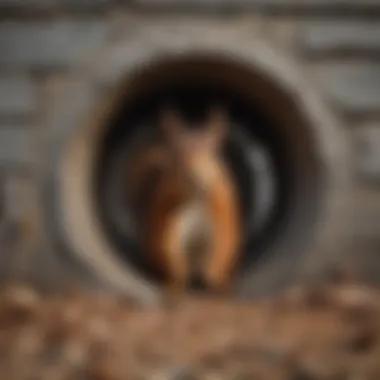
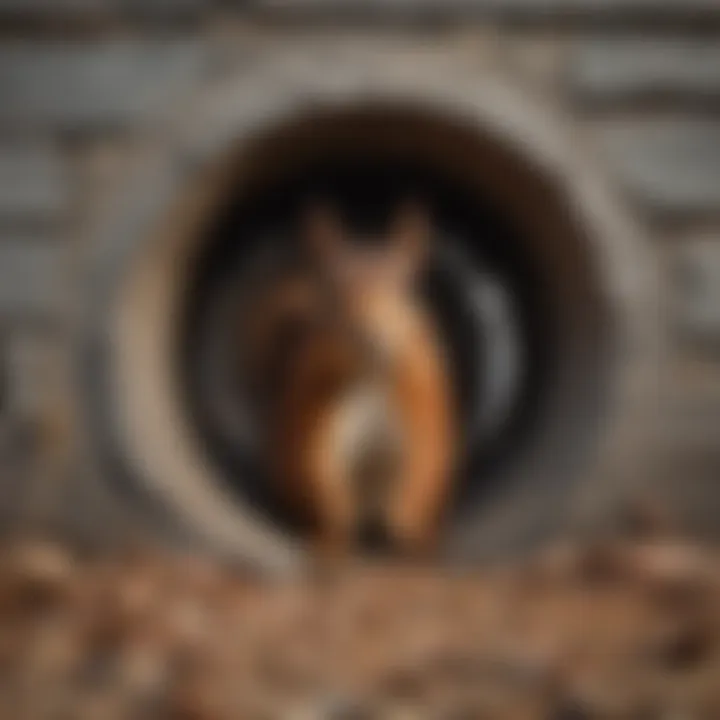
Intro
Managing squirrel populations around residential areas is both a challenge and a necessity for many homeowners. As these creatures make their homes in attics, gardens, and near bird feeders, their presence can lead to structural damage and the depletion of garden produce. This article focuses on how to effectively handle squirrel-related issues through eco-friendly and practical solutions. By understanding their behavior and implementing prevention strategies, homeowners can create an environment that minimizes these interruptions.
Understanding the Pest
Squirrels are agile rodents known for their bushy tails and quick movements. Understanding their behavior is crucial for effective control.
Identification
Identifying the species is the first step in understanding how to manage them. In North America, the most common types are the Eastern gray squirrel and the fox squirrel. Eastern gray squirrels are usually smaller with bushy tails and can be identified by their grayish fur, while fox squirrels have more reddish-colored fur and are larger in size.
Life Cycle
Squirrels breed twice a year, typically in late winter and mid-summer. The gestation period is about 44 days. This means that a small group of squirrels can grow significantly in a short time, which can lead to more damage if not controlled early. Young squirrels will leave the nest after about 10 weeks.
Pest Prevention Strategies
Preventing squirrels from taking residence in or around your property requires both environmental modifications and physical barriers.
Environment Modification
By making your home less inviting, you can deter these rodents. Here are some strategies:
- Remove accessible food sources, such as bird feeders, or use squirrel-proof feeders.
- Keep trash in secure, animal-proof containers.
- Ensure there are no fallen fruits or nuts from trees, which can attract squirrels.
Physical Barriers
Installing barriers can effectively prevent squirrels from accessing certain areas. Here are practical options:
- Cover vents and openings with metal mesh or hardware cloth to prevent entry into attics or crawl spaces.
- Trim tree branches that are too close to rooftops or power lines to eliminate pathways.
Control Methods
When prevention fails, more direct control methods may be necessary. While chemical control options exist, they should be used cautiously, as they can harm non-target species.
Chemical Control
Though not typically recommended in a residential environment, some individuals may use repellents. These are derived from natural ingredients and designed to deter squirrels without causing them harm. Examples include:
- Capsaicin-based sprays, which create an unpleasant sensation for the squirrels.
- Essential oils like peppermint, which can be unpleasant for them when applied to suspected entry points.
Biological Control
Utilizing natural predators can be effective. Owls and hawks are natural enemies of squirrels. If you can make your yard a habitat for these raptors, the squirrel population may naturally decline over time.
Effective squirrel management is not just about deterrence, but also understanding their patterns to develop a solution tailored to your specific environment.
Preface to Squirrel Management
Managing squirrels in residential areas is essential for maintaining peace and protecting property. Squirrels can become a nuisance if they invade homes or gardens, leading to potential damage and health concerns. Understanding the dynamics of squirrel behavior and knowing how to identify the species present in your area is a crucial first step in effective management.
This section examines two key elements: the behavior of squirrels and the species most commonly found in urban settings. Recognizing these factors will provide homeowners with a clearer picture of how to approach squirrel control strategies.
By addressing these topics, readers can better formulate a plan using home remedies. This approach minimizes reliance on harmful chemicals, favoring eco-friendly options that protect both the environment and local wildlife. Furthermore, proper squirrel management not only improves tranquility in the home but also contributes to the overall integrity of the property.
"Understanding the characteristics of squirrels can significantly ease management efforts."
In this introduction, we will explore how to interpret squirrel behavior patterns and identify which specific types are causing issues. Knowing this information lays the foundation for effective control methods that can be implemented in a thoughtful and sustainable manner.
Understanding Squirrel Behavior
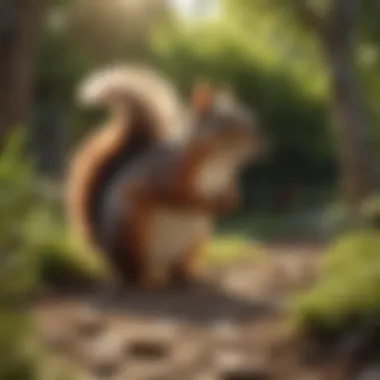

Squirrels are creatures of habit. They follow specific routines dictated by factors such as food availability and seasonal changes. These animals are primarily active during daylight hours, making them easier to observe. They exhibit foraging behavior that leads them to raid bird feeders, gardens, and even attics in search of food.
Squirrels have excellent memories, allowing them to keep track of where they stash their food. This caching behavior often results in them visiting the same spots repeatedly. Homeowners should be mindful of this aspect. If there are attractive food sources, squirrels are likely to visit those areas again and again.
Understanding their habits provides insight into how to deter them effectively. For example, eliminating food sources can discourage their return. Likewise, if you learn to recognize their movements, it becomes easier to anticipate their actions and respond accordingly.
Identifying Common Squirrel Species
In residential settings, two primary types of squirrels are often encountered: tree squirrels and ground squirrels. Each type displays distinct characteristics that can help in their identification.
- Tree Squirrels: Often found in urban trees, Eastern Gray Squirrels and Fox Squirrels are the most common species. Eastern Gray Squirrels are medium-sized with gray fur and a bushy tail. Fox Squirrels are larger, with more reddish fur.
- Ground Squirrels: These are typically smaller and live in burrows. The California Ground Squirrel and 13-lined Ground Squirrel are notable examples. They may not directly enter homes but can cause damage in yards.
Being able to identify these species accurately aids in choosing the right deterrents. Each species may respond differently to various control methods, and this understanding can greatly influence the effectiveness of your management strategies.
Assessing the Squirrel Problem
Understanding the squirrel problem is crucial for effective home management. Squirrels can become unwelcome guests if their populations are not monitored and addressed promptly. To manage these issues, it is essential to identify their signs of infestation and understand where they might access your living space. By assessing the situation, homeowners can make informed decisions on appropriate remedies and preventive measures.
Recognizing Signs of Infestation
To initiate squirrel control effectively, recognizing the signs of infestation is paramount. Squirrels can create various issues, like damaging insulation, chewing on wiring, and raiding bird feeders.
Common indicators of an infestation include:
- Noisy Activity: This may manifest as scratching or thumping sounds in the attic or walls, particularly at dawn or dusk when squirrels are most active.
- Droppings: Squirrel droppings resemble those of small rodents, about a quarter of an inch long and often found in areas where they feed or nest.
- Nesting Material: Keep an eye out for shredded materials, like leaves, twigs, and insulation, which may indicate nearby nesting sites.
- Chewed Items: Squirrels have strong teeth and will gnaw on materials to keep their incisors sharp. Evidence includes damaged wires or gnawed wood.
Addressing these signs early on can prevent more significant damage and potential costs.
Common Entry Points and Access Routes
Understanding how squirrels access homes is vital for proper control. Squirrels are agile and can enter through small openings. Most often, they exploit existing vulnerabilities around the house.
Common entry points to be aware of include:
- Rooftops: Overhanging branches can provide access to rooftops where squirrels may find gaps or openings to sneak inside.
- Vents and Chimneys: Unprotected vents or chimneys can serve as pathways for mischievous squirrels seeking shelter.
- Loosely Fitted Windows and Doors: Any gaps around doors and windows can be potential access points in your home.
- Gaps in Siding or Foundation: Inspect your house for any holes in the siding or foundation that squirrels can easily exploit.
By actively monitoring these access points, homeowners can better prevent squirrels from infiltrating their homes. Taking corrective steps early reduces the need for more drastic measures later.
Home Remedies for Squirrel Control
Home remedies offer a practical and eco-friendly approach to managing squirrel issues that homeowners might face. With the growing concern over the use of pesticides and chemicals, many are turning to natural means to deter these small rodents from invading their living spaces. Home remedies are beneficial as they can be made with readily available household items, reducing cost and environmental impact.
Moreover, these solutions address the problem without harming the squirrels, which aligns with humane treatment of wildlife. Homeowners seeking effective but non-harmful methods can benefit significantly from these remedies.
Natural Deterrents
Natural deterrents provide a range of options that many people can use to encourage squirrels to keep their distance. These methods are often safe for pets and children.
Peppermint Oil
Peppermint oil is known for its strong scent that squirrels find unpleasant. The appeal of peppermint oil lies in its natural composition; it does not pose health risks when applied correctly. Its key characteristic is that it can effectively mask scents related to food sources, discouraging squirrels from approaching.
One unique feature of peppermint oil is its ability to repel various pests beyond squirrels, making it a versatile choice. However, frequent reapplication may be required, especially during rainy conditions. Some homeowners may find that it works better in smaller areas rather than larger spaces.
Cayenne Pepper
Cayenne pepper acts as a natural irritant, which can deter squirrels when they come across it. The heat produced by cayenne is unpleasant for many animals, including squirrels. This characteristic makes cayenne pepper a popular ingredient for homemade deterrents. Many users appreciate its non-toxic nature, making it a safe option around pets.
Its unique feature is the ability to use it in various forms; whether as a powder or mixed into sprays, it can be easily customized. However, its effectiveness may diminish over time, and areas treated with cayenne may require frequent replenishment to maintain deterrent qualities.
Vinegar Solutions
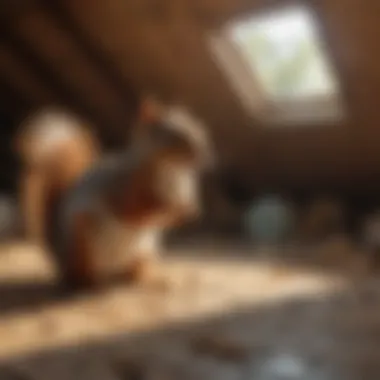
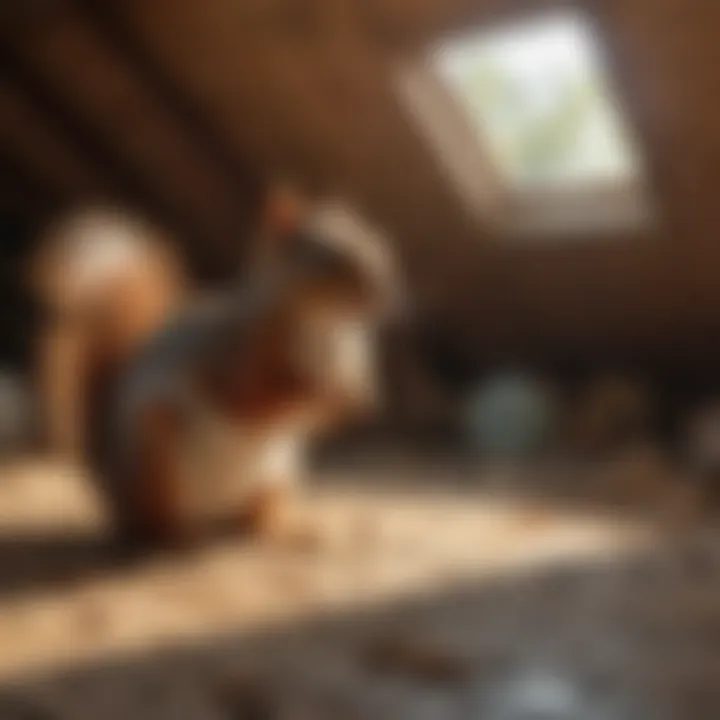
Vinegar solutions are another effective natural way to keep squirrels at bay. The strong smell of vinegar can produce a lingering effect that squirrels dislike. Homeowners utilize vinegar due to its availability and cost-effectiveness, making it a frequent choice in households.
The unique aspect of vinegar solutions is their ability to penetrate areas where squirrels may nest or feed, effectively neutralizing odors that attract them. However, the smell may be offensive to humans as well, and the vinegar scent may linger longer than desired. Users might need to balance effectiveness with smell to ensure it fits their preferences.
Physical Barriers
Physical barriers are essential for effective squirrel control, as they can prevent squirrels from accessing certain areas altogether. Employing these barriers ensures long-term solutions by addressing potential entry points head-on.
Sealing Entry Points
Sealing entry points is a fundamental step in squirrel control. Squirrels often access homes through gaps or cracks in structures. The key characteristic of sealing entry points is its straightforward implementation—most homeowners can perform this task without needing professional help.
A unique advantage is that once sealed, these points prevent any further attempts by squirrels. Nevertheless, vigilance is important; new gaps can appear over time due to wear and tear. Regular checks are necessary to maintain effective barriers against invasion.
Using Squirrel Guards
Using squirrel guards can provide a protective layer around bird feeders or other areas that attract squirrels. These guards are designed to deter squirrels while allowing other wildlife access. Their important feature is the physical barrier they create, making it difficult for squirrels to reach food sources.
Guards can be made from various materials, including metal or plastic, providing options based on aesthetic preference and functional durability. They may not be foolproof, as particularly crafty squirrels may find ways around some models.
Installing Mesh Fencing
Installing mesh fencing is a proactive measure to keep squirrels out of gardens and yards. The key characteristic of mesh fencing is its effectiveness in creating a physical barrier that is hard for squirrels to penetrate. This method can be very effective for protecting areas where squirrels may dig or forage.
One significant advantage of mesh fencing is that it is durable and can last for years, minimizing ongoing maintenance. However, initial costs and installation time may be a disadvantage for some homeowners, as this method requires planning and setup before it can be truly effective.
Repulsive Techniques
In managing squirrel populations, repulsive techniques serve as an effective strategy. These methods aim to create an environment that is uninviting to squirrels. By utilizing natural and non-chemical approaches, homeowners can discourage squirrels from making their homes in or around their properties. This method not only protects the household but also aligns with eco-friendly practices, reducing the risk of harming other wildlife.
Sound as a Deterrent
Ultrasonic Devices
Ultrasonic devices are electronic tools that emit high-frequency sounds, inaudible to humans but bothersome to pests like squirrels. The primary advantage of these devices is their ability to cover large areas without physical barriers. Users often find that these devices are easy to set up, as they require no intricate installation processes.
The key characteristic of ultrasonic devices is their ability to transmit sound waves that disrupt the normal behavior of squirrels. Many homeowners appreciate this solution for its low maintenance and non-invasiveness. However, it is important to note that ultrasound may not work in all situations. There can be interference from walls or other obstacles, reducing its effectiveness. Additionally, not all squirrels may be deterred by sound alone.
Wind Chimes
Wind chimes can be a charming addition to outdoor decor, but they also serve a practical purpose. The unpredictable sounds created by wind chimes can deter squirrels from approaching certain areas. Their rhythmic motion and melodic tones create an unsettling atmosphere for these creatures, prompting them to reconsider their presence.
Wind chimes are an economical and aesthetic choice for many homeowners looking to manage squirrel activity. They are easy to install and come in various designs, allowing for personalization while addressing the squirrel issue. However, their effectiveness may be limited to specific environments. In places with little wind or heavy noise pollution, wind chimes may not provide sufficient deterrence.
Motion-Activated Sprays
Motion-activated sprays are systems that detect movement and release a burst of water or a harmless repellent. This sudden action can startle squirrels and condition them to avoid the area. This is particularly useful in gardens or near fruit trees, preventing squirrels from raiding your produce.
Homeowners find these sprays beneficial because they do not require constant monitoring. Once installed, they take care of the issue automatically. However, it is crucial to consider the placement of these devices. They require a power source and should be positioned correctly for effective performance.
The integration of these repulsive techniques can significantly reduce unwanted squirrel interactions, enhancing the overall harmony between nature and residential life.
In summary, employing sound as a deterrent, through ultrasonic devices or wind chimes, alongside motion-activated sprays, offers a multifaceted approach to repelling squirrels. These techniques highlight the importance of non-invasive, eco-friendly methods in wildlife management.
Trapping and Relocation
Trapping and relocation play a pivotal role in squirrel control methods for homeowners dealing with squirrel infestations. Squirrels can be persistent, often returning to areas where they have previously found food or shelter. Trapping provides an immediate solution to reduce their presence. It also allows for humane methods to manage these animals without causing them harm. Importantly, understanding both the selection of traps and the ethical considerations involved is crucial for a responsible approach to this issue.
Choosing the Right Trap
When it comes to trapping squirrels, selecting the appropriate trap is essential. There are various types of traps available, but two main categories stand out: live traps and lethal traps. Here are key factors to consider in choosing the right trap:
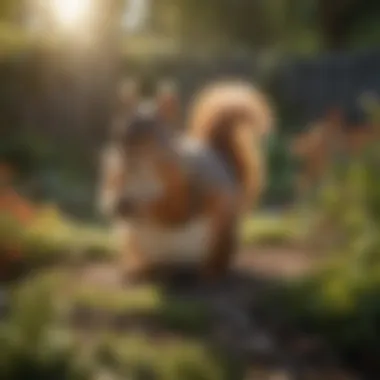

- Live Traps: These are designed to capture squirrels without harming them. Options such as Havahart traps work effectively as they allow for the safe capture of the animal, which can then be relocated elsewhere. Homeowners should ensure that the size of the trap is adequate for the species they are dealing with.
- Lethal Traps: These are often used for immediate extermination. Common examples include snap traps, which can eliminate a squirrel quickly. However, homeowners should be informed about the regulations regarding their use in their area.
- Bait Selection: Regardless of trap type, effective bait is key. Nuts, seeds, or fruit can work well. It's crucial to place the bait in a manner that attracts the squirrel into the trap while ensuring safety and effectiveness.
- Location Matters: The placement of the trap should be strategic. Areas where activity is observed, such as near nests, feeding spots, and common pathways, are ideal.
By carefully selecting the right trap, homeowners can enhance the chances of a successful capture.
Ethics of Relocation
Once captured, the ethics of relocation must be thoughtfully considered. Relocating squirrels may seem like a straightforward solution. However, it involves several significant factors:
- Legal Regulations: Many regions have strict laws regarding the relocation of wildlife. It is vital to check local regulations to follow the law and avoid potential fines.
- Survivability: Relocating a squirrel far from its original habitat poses risks. The animal may struggle to adapt to new surroundings or face threats from local predators. Therefore, relocating must be executed with care, preferably in proximity to areas that can support the animal.
- Community Awareness: Relocating away from urban areas may inadvertently lead to population increases in nearby locations. This can create further problems for other communities. Homeowners should think about the broader implications of their actions.
"Trapping and relocating squirrels requires not just action but also responsibility to ensure humane treatment of these creatures and compliance with local guidelines."
Long-Term Prevention Strategies
Long-term prevention strategies are essential in managing squirrel problems effectively. While immediate remedies can provide temporary relief, sustainable practices will ensure that squirrels do not return to cause issues. It helps homeowners not just to react but to proactively maintain their environment, fostering a squirrel-free space for the long run. Moreover, adopting a comprehensive approach that includes preventive measures is substantially more efficient than continually dealing with infestations.
This section explores vital tactics, including landscape modifications and regular maintenance routines that can significantly deter squirrels.
Landscape Modifications
Making strategic changes to your landscape can greatly minimize the chances of squirrel attraction. Squirrels are generally attracted to areas that provide cover and easy access to food sources. Here are some modifications to consider:
- Plant Selection: Choose plants that are less appealing to squirrels, such as certain varieties of flowers and shrubs. Avoid ornamental fruits and nuts, as they may attract squirrels to your garden.
- Remove Food Sources: Make sure to clean up any fallen fruits, nuts, or seeds. Bird feeders are common places where squirrels gather food. Consider using squirrel-proof feeders to limit access to food.
- Maintain Trees and Shrubs: Trim branches that are close to your house or overhanging roofs. This will prevent squirrels from using these as pathways into your home.
- Mulching: Use coarsely shredded organic materials for landscape mulch. Squirrels tend to dislike certain types, such as pine needles, because it is harder for them to dig through.
Implementing these landscape modifications creates a less inviting environment for squirrels. It’s also an ongoing process that requires attention to get the best results.
Regular House Maintenance
Regular house maintenance plays a critical role in preventing squirrel-related issues. By being diligent in the upkeep of your home, you can reduce potential entry points and remove habitats that attract squirrels. Here are key areas to focus on:
- Inspect for Entry Points: Regularly check for gaps, holes, or cracks around your home’s foundation, walls, and roofs. Seal any openings larger than a quarter, as these provide easy access for squirrels.
- Gutters and Roof Inspection: Clean and maintain gutters to avoid blockage, which can lead to structural issues. Ensure that your roof is intact, free from damage, and without overhanging branches.
- Store Materials Properly: Keep outdoor items such as firewood, pet food, and garden supplies stored securely. This minimizes the chances of attracting squirrels to your property.
- Install Screens: Ensure that vents, chimneys, and other openings are covered with mesh screens. This acts as a barrier, deterring squirrels from entering.
In summary, effective long-term prevention strategies focus on proactive measures that address the root causes of squirrel attraction. By modifying your landscape and maintaining your home, you can create a lasting impact on reducing squirrel activities.
Legal Considerations
When addressing squirrel control, it is crucial to consider the legal framework that governs wildlife management in your area. Complying with these regulations not only helps protect local wildlife but also safeguards homeowners from potential legal consequences. Knowledge of the laws ensures that any actions taken to manage squirrels are justified and lawful. Furthermore, adhering to legal standards fosters ethical wildlife management practices that align with conservation efforts.
Understanding Local Wildlife Regulations
Local wildlife regulations vary significantly between regions, making it imperative for homeowners to familiarize themselves with the specific rules in their locality. These laws often dictate:
- Species Protection: Certain squirrel species may be protected under local or federal laws. Killing or relocating these animals without proper authorization could lead to legal penalties.
- Trapping Practices: Many jurisdictions require homeowners to follow specific trapping protocols. This includes the type of traps allowed, locations where traps can be set, and the status of the captured animals.
- Feeding Wildlife Restrictions: Some areas prohibit feeding wildlife, including squirrels. Such regulations are designed to prevent dependency, which can lead to overpopulation or aggressive behavior.
Before implementing any control measures, homeowners should consult local wildlife agencies or official websites. Being aware of these regulations shows responsibility as a caretaker of the environment.
Permits for Trapping and Relocation
In many instances, a permit is necessary for trapping and relocating squirrels. The process of obtaining such permits serves several purposes:
- Ensures Compliance: It helps homeowners ensure that their actions are in compliance with state and local laws. Failure to obtain a permit when needed can result in fines or other penalties.
- Promotes Safe Practices: Permits often come with guidelines that inform homeowners about safe and humane trapping and relocation methods, reducing the risk of harm to the animals or to themselves.
- Helps Monitor Wildlife Populations: Regulatory bodies track permits to understand population dynamics of local wildlife. This information is vital for conservation efforts and managing ecosystem health.
To secure a permit, homeowners typically need to submit an application to the relevant wildlife agency. This process may involve providing detailed information about the intended trapping and relocation actions, ensuring that they align with conservation goals.
Understanding and complying with the legal aspects of wildlife management is essential for effective and ethical squirrel control. By respecting local regulations, homeowners can contribute positively to local ecosystems.
Epilogue
Addressing the issue of squirrel control in residential areas is crucial for the overall comfort and safety of homeowners. Effective home remedies offer accessible solutions that do not rely on harmful chemicals, thus promoting a more sustainable approach to pest management. It is essential to understand that squirrels, while often considered cute or harmless, can cause significant damage to property and pose health risks due to potential diseases.
Summary of Effective Home Remedies
The article outlines several practical remedies that can be employed to deter squirrels. Natural deterrents such as peppermint oil, cayenne pepper, and vinegar solutions can create inhospitable environments for these pests. Similarly, implementing physical barriers by sealing entry points and using squirrel guards can prevent access to attics and basements. In addition, repulsive techniques, including the use of ultrasonic devices and motion-activated sprays, provide immediate solutions to discourage squirrel activities.
Moreover, trapping and proper relocation of squirrels should be done ethically, ensuring compliance with local wildlife regulations. Long-term prevention strategies, consisting of landscape modifications and regular house maintenance, are vital to mitigating future squirrel infestations. By integrating these methods, homeowners can effectively manage squirrel populations while maintaining a safe and comfortable living environment.
Importance of Sustainable Practices
Sustainable practices in pest control not only align with environmental responsibility but also ensure the safety of pets and children in the household. Using eco-friendly remedies fosters a balance between human needs and wildlife conservation. It is imperative to consider the impact of one’s choices on the eco-system. Adopting non-toxic solutions reduces the likelihood of harming beneficial organisms while effectively managing unwanted wildlife.







